The 9 Beautiful Husky Colors

Huskies are attractive, loyal, and mischievous pups who love to be part of a big pack. Originally bred as sled dogs, these pups have great stamina and can pull light loads for miles over snow and ice. Whilst they were once an important part of a nomadic family’s life in Siberia, Huskies can nowadays be found as family favorites in many countries. This wonderful breed is even known for being able to talk – but can Huskies really communicate? Not only are they loyal, goofy, and smart but Siberian Huskies also come in many different colors – meaning there’s a Husky for everyone. But what are all the Husky colors? And which are accepted as standard if you want to enter your pup into a competition?
Siberian Husky Colors – What Do The Kennel Clubs Say?
Different kennel clubs have different breed standards, so it can be a bit complicated to understand whether your pup qualifies for entry into a show or competition. Here’s what the various kennel clubs categorize as standard.
American Kennel Club
According to the AKC, the following Husky colors are recognized in the breed standard.
- Agouti and white
- Black
- Black and white
- Black tan and white
- Brown and white
- Gray and white
- Red and white
- Sable and white
- White
They also mention that saddleback markings are acceptable.
United Kennel Club
The UKC states that all colors, from black to pure white, are allowed. They also state that it’s common for Huskies to have many striking and unusual markings on their head.
Federation Cynologique Internationale
The FCI accepts Huskies in black, gray, agouti, sable, red, and white. Ranges of shades within these colors are allowed and a Husky may be multi-colored with white markings. They also accept a piebald coat pattern.
So, as you can see, Siberian Huskies can come in a number of different coat colors and patterns!

What Type of Coat Do Huskies Have?
Regardless of what color coat your pup has, they’ll have a thick, double coat that helps keep them warm in winter. This means they have a soft, downy undercoat and an outer coat of coarser guard hairs.
Huskies shed their undercoat just before the warmer months (and then again just before winter). This allows them to grow a new coat more suitable to the upcoming climate. You can expect even more hair around your home during these times! They’re definitely not a hypoallergenic dog breed! Make sure you rake out the shedding coat using a pin brush or metal comb to avoid excess hair on your clothes and furniture. It also helps keep their coat and skin healthy and distribute essential oils.
Because Huskies are used to cooler climates (and have a thick coat to protect them) they don’t do well in hot places or weather. Make sure they have plenty of water and are in shady areas outside. You might want to get them an outdoor dog bed to keep them comfortable!
Is Color Really That Important?
The most important thing to consider when adopting a Siberian Husky is the health of the animal and whether you can provide the living conditions it needs. You should always research your Husky breeder and ensure that they’re ethical (the Siberian Husky Club is a good place to start). The breeder should be able to provide you with all the documentation you need.
Huskies are active dogs that like to exercise a lot. They love hiking, running, and playing in the dog park and will enjoy it even more if you give them something to carry. They love having a job to do and need an active family that can meet their needs. These pups are escape artists, however, so don’t leave them to play in the yard by themselves. Always keep an eye on them and maybe consider getting them a dog GPS collar in case!
Siberian Husky Colors
Here are the possible coat colors for Huskies according to the AKC.
Agouti and White Siberian Husky
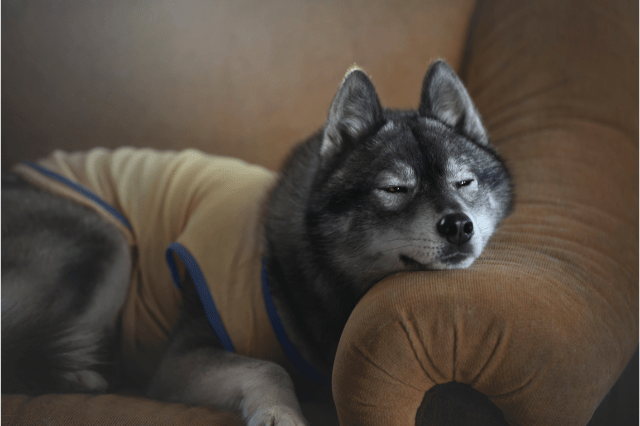
Dogs that have the agouti gene will have a very unique, wolf-like coat. In fact, it’s often referred to as wolf sable. This coat type is common amongst rodents and horses but isn’t seen as much in the canine world. This wild-type coloring means that each individual hair has many different bands of color (usually tan and black).
Agouti Huskies have a darker face, which some refer to as looking dirty, but the coloring spreads right the way across their bodies. The hairs are normally black at the root and the tip and may have red or tan in the middle. They might also have patches of white. Because it’s such a difficult coat color to pinpoint exactly, these doggos are often mistaken for being sable.
Black Siberian Husky

Black Siberian Huskies are really impressive-looking dogs – they’re also very rare. In most cases, dogs that are considered black still have some white markings on their face, chest, tail, and legs (just like the adorable little paw above). To be classified as a black Siberian Husky, a dog has to be a minimum of 75% black. These pups are usually jet black but they can be more of a gray color too. Nose and lip pigmentation must be black.
Black and White Siberian Husky
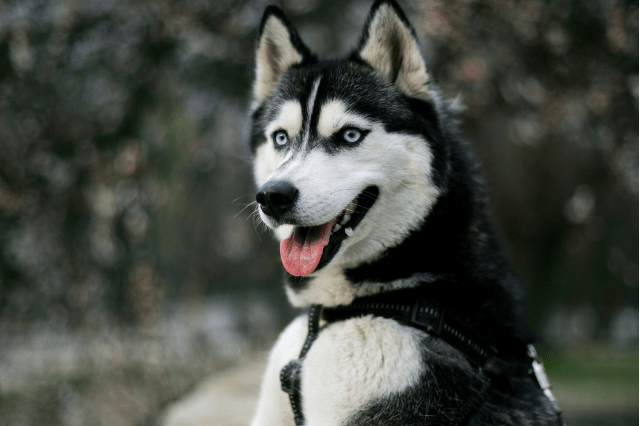
Black and white Huskies are a pretty common coat color for these sled dogs. Unlike the black Husky, they have much more white on their bodies (and often cute little white eyebrows)! The black color can vary in intensity and be very dark or much lighter and even appear silvery.
Black, Tan, and White Siberian Husky

A black, tan, and white Husky has a particularly beautiful tri-colored coat. It’s also extremely rare. These pups have a white and black coat with tan markings which can appear more reddish or beige.
Brown and White Siberian Husky
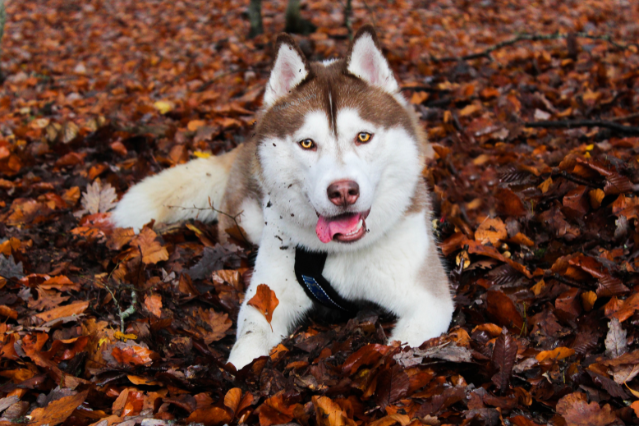
This coat coloring is very similar to that of the black and white Husky but instead of black areas they have brown. This brown can be a dark shade and even range to a light red. A brown and white Husky can be further classified into copper and sable.
Copper Husky
Copper dogs have coats that range from being more yellow to deep, reddish-brown. They may be chocolate copper, red copper, or orange copper.
Sable Husky
Sable doggos always have banded hairs (two or more bands of pigmentation in a hair) that have black tips. The undercoat may be red, chocolate, or orange.
Gray and White Siberian Husky
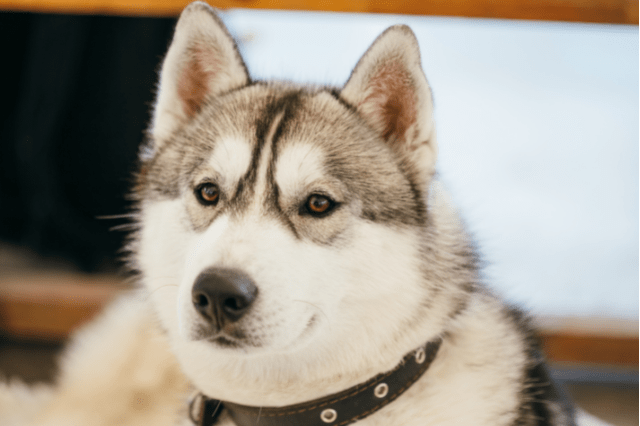
A gray and white dog has similar markings to a black and white Husky and a brown and white Husky. The gray can also be categorized into silver, wolf gray, and medium/dark gray.
Silver Siberian Husky
Unlike the agouti coat (wolf gray) these dogs have a silvery/blue tone. They don’t have tan, beige, or red patches or bands on their hair and their undercoat is pure white. They sometimes have black points which can give them a distinctive silver look.
Medium/Dark Siberian Husky
This is the most common of the gray Siberian Huskies. Pups with this color can have red and tan tones but they’re not as intense as others. The undercoat is usually beige or silver.
Wolf Gray Siberian Husky
This coat color is the wild, wolfish coat produced by the agouti gene (as mentioned above). It’s usually quite a dull gray color. This is why Huskies are often considered wolf-like dogs!
Red and White Siberian Husky
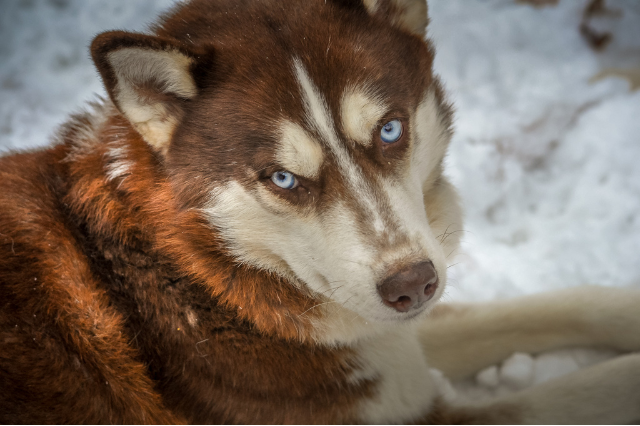
Red Huskies have an amazingly intense colored coat. These pups differ from copper or brown dogs (which can have quite a red hue) because of the liver points in the nose, lips, and eye rims (they’re pink or pinky-brown rather than black). They also don’t have any black hairs.
Sable and White Siberian Husky

Sable Huskies are sometimes called ‘black-nosed reds’ because their coats can look similar, but they don’t have the liver pigmentation that reds do. Sable Huskies have a red undercoat but never have a beige one which agoutis can. Some sable Huskies are born with a wolf-gray coat which can change to sable over time.
White Siberian Husky
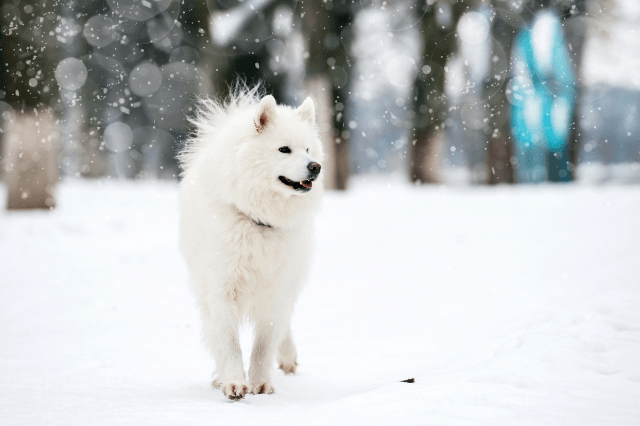
The white coat of these dogs is particularly eye-catching (and really makes them look like they’re wolves in a snowy landscape)! The hairs may be pure white or they might have a yellowish tinge. It’s also possible that white Huskies have a few black guard hairs.
What About Husky Eye Color?
One of the most striking things about Huskies is their eye color. Anyone who has ever seen one is sure to remember those inquisitive, brightly colored eyes. Many Huskies have deep brown eyes, some electric blue, and others very warm, amber eyes. White Huskies and red and white Huskies tend to have amber eyes more than any others.
But it’s also fairly common for Huskies to have different colored eyes or partially colored eyes. Huskies with split eyes have two different colors in one iris. For example, the top half may be bright blue and the bottom half amber. Both eyes can be split or just one.
Huskies can also be parti-eyed which means the main color is, for example, amber and they have spots of another color. This is a rare form of eye color for Huskies.
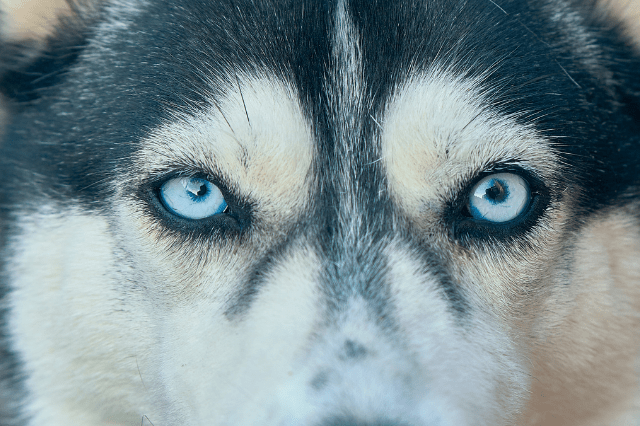
Husky Coat Patterns
Black points and piebald are considered standard for Huskies. Merle, however, should be avoided – especially double merles (when both parents have the merle gene). Although very pretty, this gene can cause serious health concerns such as blindness. You can find out more about standard merle dog breeds in this blog.
Does Coat Color Affect Personality?
It’s important to be realistic when adopting a pup and make sure that you can deal with the size and temperament of that dog breed. The good news, however, is that the color of your Husky won’t affect its personality. As long as you adopt them from a responsible breeder, you’re free to choose the color you like most!
Siberian Husky Colors – Which Should You Choose?
One of the best things about Huskies, apart from their adorable personalities, is that they come in so many different colors (and even more if they’re a Husky mix like the Pitsky). The ones on this list are just the standards but there are a few more. If you want to enter your pup into a show, any of these would be accepted. It’s important you avoid merle pups and always adopt from a breeder that puts their dog’s health first. Huskies are incredible dogs that make great family pets – whatever their color!
If you found this interesting, check out our post on all the Yorkie colors!
